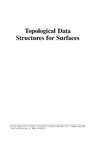In Geography and GIS, surfaces can be analysed and visualised through various data structures, and topological data structures describe surfaces in the form of a relationship between certain surface-specific features. Drawn from many disciplines with a strong applied aspect, this is a research-led, interdisciplinary approach to the creation, analysis and visualisation of surfaces, focussing on topological data structures.
Topological Data Structures for Surfaces: an introduction for Geographical Information Science describes the concepts and applications of these data structures. The book focuses on how these data structures can be used to analyse and visualise surface datasets from a range of disciplines such as human geography, computer graphics, metrology, and physical geography. Divided into two Parts, Part I defines the topological surface data structures and explains the various automated methods used for their generation. Part II demonstrates a number of applications of surface networks in diverse fields, ranging from sub-atomic particle collision visualisation to the study of population density patterns. To ensure that the material is accessible, each Part is prefaced by an overview of the techniques and application.
- Provides GI scientists and geographers with an accessible overview of current surface topology research.
- Algorithms are presented and explained with practical examples of their usage.
- Features an accompanying website developed by the Editor - http://geog.le.ac.uk/sanjayrana/surface-networks/
This book is invaluable for researchers and postgraduate students working in departments of GI Science, Geography and Computer Science. It also constitutes key reference material for Masters students working on surface analysis projects as part of a GI Science or Computer Science programme.
Content:
Chapter 1 Introduction (pages 1–12): Sanjay Rana
Chapter 2 Topographic Surfaces and Surface Networks (pages 13–29): Gert W. Wolf
Chapter 3 Algorithms for Extracting Surface Topology from Digital Elevation Models (pages 31–51): Shigeo Takahashi
Chapter 4 Construction of Metric Surface Networks from Raster?Based DEMs (pages 53–70): Bernhard Schneider and Jo Wood
Chapter 5 Contour Trees and Small Seed Sets for Isosurface Generation (pages 71–85): Marc van Kreveld, Rene van Oostrum, Chandrajit Bajaj, Valerio Pascucci and Dan Schikore
Chapter 6 Surface Shape Understanding Based on Extended Reeb Graphs (pages 87–102): Silvia Biasotti, Bianca Falcidieno and Michela Spagnuolo
Chapter 7 A Method for Measuring Structural Similarity among Activity Surfaces and Its Application to the Analysis of Urban Population Surfaces in Japan (pages 103–120): Atsuyuki Okabe and Atsushi Masuyama
Chapter 8 Topology Diagrams of Scalar Fields in Scientific Visualisation (pages 121–129): Valerio Pascucci
Chapter 9 Topology?Guided Downsampling and Volume Visualisation (pages 131–142): Martin Kraus and Thomas Ertl
Chapter 10 Application of Surface Networks for Augmenting the Visualisation of Dynamic Geographic Surfaces (pages 143–155): Sanjay Rana and Jason Dykes
Chapter 11 An Application of Surface Networks in Surface Texture (pages 157–166): Paul J. Scott
Chapter 12 Application of Surface Networks for Fast Approximation of Visibility Dominance in Mountainous Terrains (pages 167–176): Sanjay Rana and Jeremy Morley
Chapter 13 Issues and Future Directions (pages 177–183): Sanjay Rana
 |
|
О проекте
|
|
О проекте


